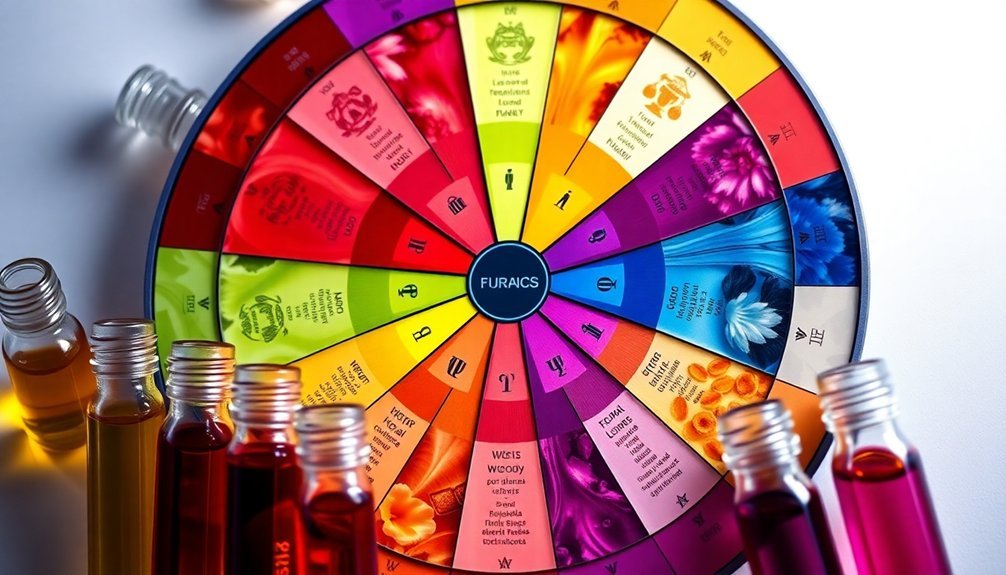To create perfectly balanced perfumes, you'll want to follow the fragrance wheel's proven ratios across its four main families: Floral, Amber, Woody, and Fresh. Start with a classic 30-50-20 distribution of top, middle, and base notes. For your main scent family, allocate 40-50%, then complement with 20-30% from supporting families. You can adjust these proportions seasonally, increasing fresh top notes in summer and warming base notes in winter. Master these foundational ratios to reveal endless aromatic possibilities.
Understanding The Core Elements Of The Fragrance Wheel

Every successful perfume composition begins with a solid understanding of the fragrance wheel's core elements.
You'll discover four primary scent families that form the foundation of all fragrances: Floral, Amber (Oriental), Woody, and Fresh. Each family brings its unique character to the table, from the sweet florals of jasmine and rose to the rich, warm notes of vanilla and cinnamon in the Amber family.
When you're creating a perfume, think of the fragrance wheel as your roadmap to achieving the perfect top note and overall scent harmony.
You can explore various subfamilies within each category to find complementary aromas that work together. This systematic approach helps you identify which scents will blend seamlessly and which will create intentional contrasts in your fragrance compositions.
The Science Behind Scent Family Proportions
While creating the perfect fragrance requires artistic intuition, it's the precise ratios of scent families that transform a simple blend into a masterpiece.
The scent wheel guides you through the delicate balance of proportions across different fragrance families.
You'll find that floral scent compositions thrive with 50-60% middle notes, while woody fragrances demand stronger base notes at 40-50%.
When working with amber scents, aim for 30-40% base notes to achieve that luxurious, lasting impression.
Fresh fragrances break this pattern by emphasizing top notes up to 60%, perfect for capturing summer's essence.
A well-balanced perfume typically follows a 30-40% top note, 40-50% middle note, and 20-30% base note distribution.
However, you can adjust these ratios according to your chosen fragrance family's unique characteristics.
Essential Ratios For Blending Fragrance Families

Building on the core note ratios, successful fragrance blending demands precise proportions between scent families.
You'll want to start with a 30-40% foundation from your dominant family, then layer in 20-30% from supporting families to create balance.
For complex fragrances, follow the 60-20-20 principle: 60% from your primary family, with two complementary families at 20% each.
When working with sub-family blends, guarantee your main scent family makes up at least 50% of the formula.
If you're new to perfumery, try the industry-standard 40-30-30 ratio: 40% floral, 30% woody, and 30% fresh notes.
Remember to maintain the classic structure of 50% top notes, 30% middle notes, and 20% base notes within these family ratios for a well-rounded composition.
Balancing Top, Middle, And Base Notes
To create a harmonious fragrance, you'll want to start with 20-30% top notes for that initial burst of scent, followed by 30-50% middle notes to form the perfume's core character.
You can achieve balance by incorporating 20-30% base notes, which provide the lasting foundation and depth of your creation.
When crafting seasonal scents, you may adjust these ratios – increasing fresh top notes for summer blends or amplifying warm base notes for winter fragrances.
Perfume Note Distribution Basics
Understanding perfume note distribution is essential for crafting well-balanced fragrances.
You'll find that the classic 30-50-20 ratio serves as an excellent starting point for your fresh scent creation. This organization and description of notes guarantees a harmonious blend that evolves beautifully on the skin.
When designing your fragrance, consider these fundamental distributions:
- Top notes should comprise 20-30% of your blend, featuring light, ephemeral elements that create the initial impression.
- Heart notes make up the largest portion at 30-50%, establishing the fragrance's core personality through floral and spice elements.
- Base notes account for 20-40%, providing a rich foundation that anchors the composition and assures longevity.
This balanced approach helps you create a well-structured scent that shifts smoothly from first spritz to final dry-down.
Seasonal Scent Blending Ratios
While the classic 30-50-20 ratio serves as a foundation for perfume creation, seasonal variations demand different proportions to match environmental conditions and wearing habits.
For summer fragrances, you'll want to shift toward a higher concentration of top notes at 60%, with mid notes at 30% and base notes at just 10%. This creates those fresh, airy scents perfect for hot weather.
In contrast, winter seasonal scent blending calls for a richer composition, with 50% base notes providing lasting warmth, supported by 30% mid notes and 20% top notes.
You don't need to stick rigidly to these ratios – trust your instincts and adjust based on your preferences.
Consider how long you want the fragrance to last: summer scents can be lighter and more fleeting, while winter fragrances should linger with deeper, warmer undertones.
Seasonal Adjustments In Fragrance Wheel Measurements

Just as nature shifts its palette throughout the year, perfume compositions require careful seasonal adjustments to their fragrance wheel measurements.
You'll find that each scent family adapts to seasonal changes, creating harmony between your fragrance and the environment.
- During summer months, you'll want to increase your top notes to 30-40%, focusing on fresh citrus sub-families like bergamot and lemon for that essential burst of refreshment.
- Winter calls for a dramatic shift, where base and mid notes should dominate up to 60% of your composition, incorporating rich vanilla and wood notes.
- Your floral ratios need precise seasonal adjustments too – opt for soft florals in summer, while reserving spicier, heavier floral notes for fall and winter blends.
These measured adaptations guarantee your fragrances perfectly complement each season's unique character.
Professional Tips For Achieving Perfect Scent Balance
To create a harmonious fragrance composition, you'll want to blend adjacent scent families on the fragrance wheel while maintaining the classic 30-50-20 ratio of top, middle, and base notes.
When working with heavy base notes, you can adjust this ratio up to 25% for stronger winter fragrances, ensuring your scent has staying power throughout the day.
You'll achieve the best results by strategically layering complementary notes from opposite sides of the wheel, such as floral with woody or fresh with oriental, creating depth and complexity in your final blend.
Blending Adjacent Scent Families
Creating perfectly balanced fragrances requires understanding the delicate interplay between adjacent scent families on the fragrance wheel.
When you're blending adjacent scent families, aim for a 60/40 ratio between your primary and secondary notes to guarantee they complement each other nicely. For instance, pair Floral with Woody notes, or combine Soft Floral with Fresh Citrus for a harmonious blend.
- Start with your dominant scent family, maintaining a 70% concentration while adding 30% from an adjacent family.
- Use connecting notes to bridge gaps between families, such as green notes connecting Fresh and Woody scents.
- Test your blends directly on skin, as chemical interactions can alter the fragrance's balance.
Remember to work with the fragrance wheel systematically, focusing on adjacent families that naturally enhance one another while maintaining proper ratios for peak results.
Balancing Top-Base Note Ratios
Building upon our understanding of adjacent scent families, mastering the balance between top, middle, and base notes becomes the next vital step in perfume creation.
You'll want to start with the widely-accepted 30-50-20 ratio as your foundation, where top notes make up 30% of your fragrance composition, middle notes 50%, and base notes 20%.
Remember that your top notes create the significant first impression but fade quickly, while base notes provide lasting depth.
When selecting materials, pair lighter top notes like citrus with substantial base notes such as woods or resins for ideal harmony.
While these ratios serve as a reliable starting point, don't be afraid to experiment. You can adjust the proportions based on your creative vision and desired scent profile to craft unique, personalized fragrances.
Strategic Layering For Longevity
While mastering the basic 30-50-20 ratio is essential, strategic layering techniques can greatly enhance your fragrance's longevity and complexity.
To maximize your scent's staying power, start with oil-based foundations or matching scented lotions before applying your perfume. Understanding how different scent families interact will help you create sophisticated combinations that last throughout the day.
Here's how to layer effectively for maximum longevity:
- Begin with the heaviest concentration first, typically your base notes or fixatives like musks and resins.
- Apply complementary scented lotions from the same scent family to create a lasting foundation.
- Finish with lighter, alcohol-based fragrances on top, making sure each layer has time to settle before the next application.
This strategic approach guarantees your carefully crafted scent profile maintains its integrity while extending wear time considerably.
Advanced Techniques For Multi-Family Blending
To master multi-family blending, you'll need to understand the delicate balance between different scent families and their interaction over time.
While focusing on one scent family can create simple fragrances, multi-family blending opens up endless possibilities for complex aromas.
Start by allocating 30% to 50% to your dominant family, then carefully distribute the remaining percentages among complementary notes.
You'll find success by considering evaporation rates – fresh and floral notes dissipate quickly, while woody and amber notes provide lasting depth.
Try a 40-30-30 ratio between floral, woody, and fresh elements as your starting point.
The fragrance wheel serves as your roadmap for identifying compatible combinations.
For instance, you can pair citrus notes with amber to create an intriguing balance between invigorating and warm elements.
Frequently Asked Questions
What Is the Perfect Perfume Ratio?
You'll find there's no absolute perfect perfume ratio. While many perfumers start with 20-30% top notes, 30-40% middle notes, and 40-50% base notes, you should adjust these based on your preferences.
What Is the 30 50 20 Rule for Perfume?
You'll want to blend your perfume with 30% top notes for initial impact, 50% middle notes for the main character, and 20% base notes for lasting depth. This creates a well-balanced fragrance.
What Is the Ratio for Roll on Perfume?
You'll want to mix 20-30% fragrance oil with 70-80% carrier oil like jojoba or fractionated coconut oil. For essential oils, keep the concentration at 1-3% to guarantee safe skin application.
What Is the Best Mixture for Perfume?
You'll want to blend 20-30% fragrance oils with 70-80% alcohol and a small amount of water. For a well-balanced perfume, use 30% top notes, 50% middle notes, and 20% base notes.
In Summary
You've now mastered the basics of fragrance wheel ratios and precise perfume blending. Remember, there's no single "perfect" formula, but you'll create exceptional scents by following the 30-40-30 rule for your base, middle, and top notes while adjusting seasonal ratios. Trust your nose, keep detailed records of your successful blends, and don't be afraid to break traditional rules once you understand them.





Leave a Reply